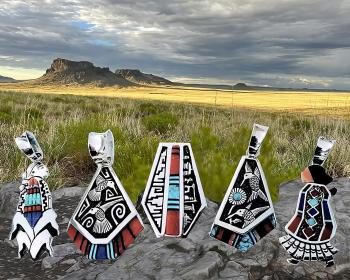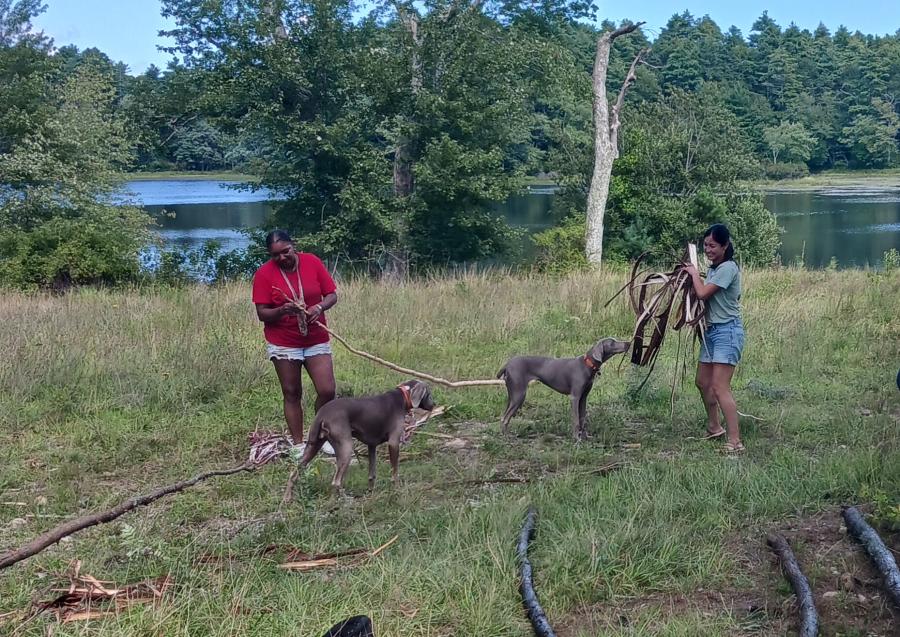Location, Land, and Climate
Archeologists think the Navajo reached the American Southwest sometimes after 1300. Although the Spanish explored the region in the 1500s and 1600s, the Navajo had little contact with them until almost 1700. The Spanish lost control of the region in the late 1600s, but during their reconquest of 1696, Jemez, Tewa, and Keresan Pueblo Indians retreated with the Navajo to what is now northeast Arizona and northwest New Mexico.
After U.S. attacks on the Navajo in 1846 and 1963, a treaty reduced Navajo territory to a fourth its previous size. The Navajo today have four reservations; the largest one surrounds the Hopi Pueblo reservation in Arizona. The other three are in New Mexico. About 190,000 Navajo live in the United States, with 146,000 on reservations.
The Navajo reservations are on the high Colordo plateau. Most precipitation falls in the winter and summer. Unpredictable and intense summer thunderstorms often wash out dirt roads and trigger flash floods, damaging ground cover and crops. The rest of the year, temperatures are high and humidity low.
Livelihood
Originally hunters and gatherers, the Navajo developed an agricultural economy through contact with their Pueblo neighbors and the Spanish. The Navajo depend on agriculture and live-stock but supplement their income through commerce in native crafts. In addition, contracts for resources such as timber, oil, coal, uranium, and gas provide the Navajo nation with income, and many men work on the railroads.
In World War II, many Navajo worked outside the reservation. The shortage of such jobs after the war and in the early 1960s led Navajos and other Native Americans to migrate to cities. Relocation damaged the traditional system of pooled family resources and support.
Cultural Systems
Until the 1850s, the Navajo were independent of colonial, political, and missionary controls. They maintained an informal, decentralized political, social, and economic system centered on local land-use groups organized around clan, domestic, and genealogical affiliations. Each local band had a leader who directed negotiations among adults.
With the discovery of oil on Navajo land in 1922, non-Navajo companies needed local authorities with whom they could negotiate contracts. In 1923, the U.S. government appointed three Navajo men as a business council to deal with lease grants, and in 1938 instigated the formation of the Navajo Tribal Council. Since the 1930s, conflicts over U.S.-directed change - involving acculturation relocation, livestock reductions, and land disputes - have raged between the Navajo and Washington.
Navajo religion explains the universe as ordered, beautiful, and harmonious. Navajo religion emphasizes rituals to restore the harmony, balance, and order expressed by the word "hozho." Harmony and balance are disrupted by death, violence, and evil. Each ritual is inspired by myths illustrating the origins of the people through different worlds or existences, the mountains, the sun, and the moon. Chanters devote their lives to learning certain ceremonies - for example, the Life Way, the Evil Way (Ghost Way), the Game Way (hunting), and the Mountain Top Way. Social events and dances usually accompany each ceremony. Each of the over 500 documented sand paintings of the Navajo parallels a particular chant.
Despite external threats, the Navajo find strength and direction by maintaining their traditions. The oftrepeated ceremonial words "Sa'ah naaghaii bikeh hozho" signify the struggle for a long life in beauty, order, and harmony with the environment.
SUGGESTED READINGS
Bertha P. Dutton, Indians of the American Southwest, Prentice-Hall, 1975.
Gladys A. Reichard, Navajo Religion, Princeton university Press, 1950.
Gary Witherspoon, Language and Art in the Navajo Universe, University of Michigan Press, 1977.
Gary Witherspoon, Navajo Kinship and Marriage, University of Chicago Press, 1975.
The novels of Tony Hillerman.
SUPPORT ORGANIZATIONS
American Indian Cultural Foundation, Box 3776, Page, AZ 86040
Navajo Tribal Council, Speaker of the House, Nelson Gorman, P.O. Box 308, Window Rock, AZ 86515.
Current Problems
Land disputes are the Navajo's most pressing problem. In 1974, Congress passed Public Law 93-531, ostensibly to resolve a land dispute between the Hopi and Navajo in Arizona. The law called for relocating almost 11,000 Navajo. Although the deadline for relocation was July 1986, about 1,000 Navajo people still occupy the disputed land on Big Mountain. The police harass the remaining Navajo, say Navajo leaders, and federal agents confiscated their sheep. While not denying that a dispute exist with the Hopi, Navajo leaders contend that oil companies and the government have exaggerated the situation for political expediency and financial gain. The area in question has a rich vein of coal and evidence of oil deposits.
The dispute extends into attacks on Navajo religion. In October 1989, the courts dismissed a Navajo suit that claimed the relocation violated their First Amendment right to freedom of religion. The Navajo religion is integrally related to the land they'd inhabit. Federal courts have also ruled that it is illegal for the Navajo to use peyote, even in a religious context.
Article copyright Cultural Survival, Inc.



